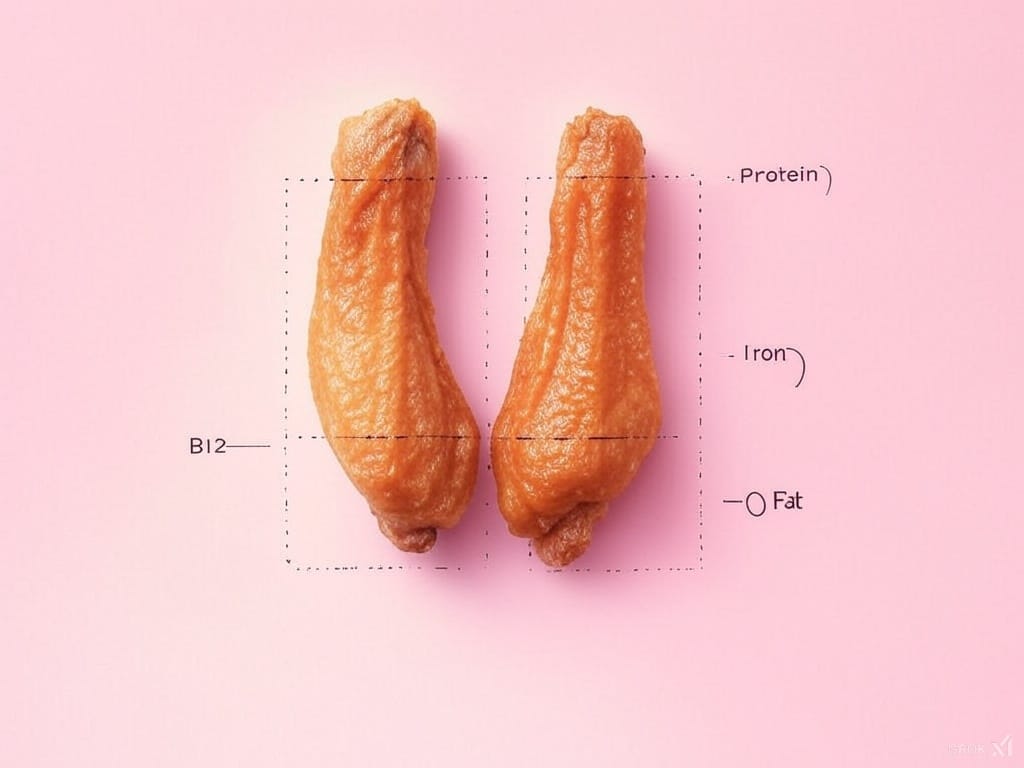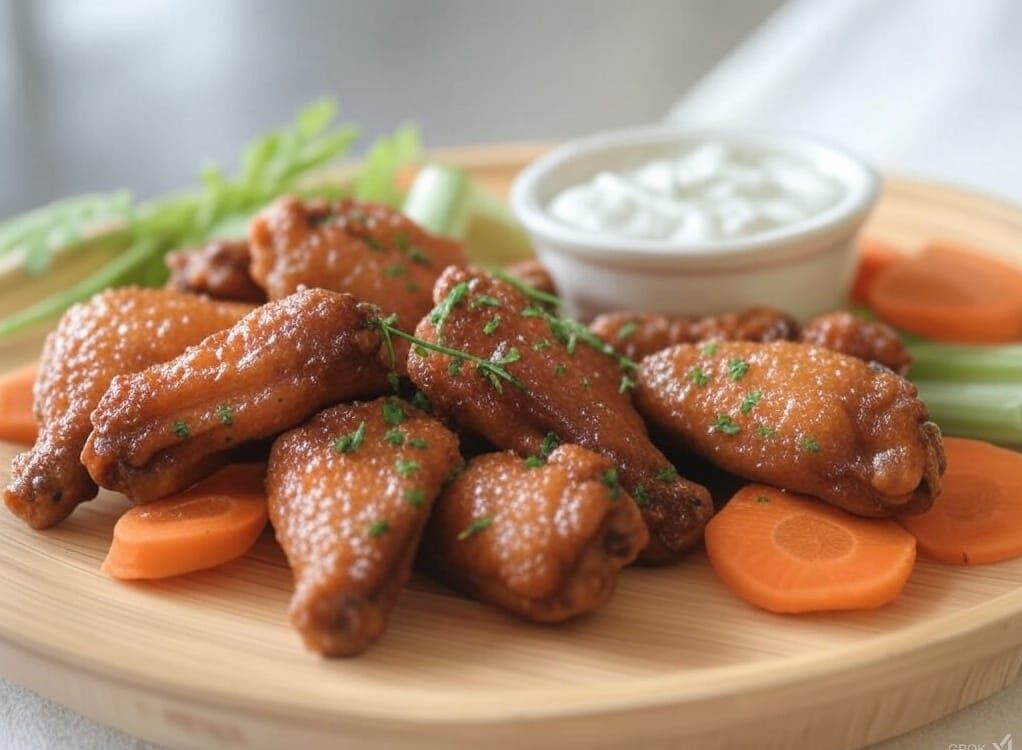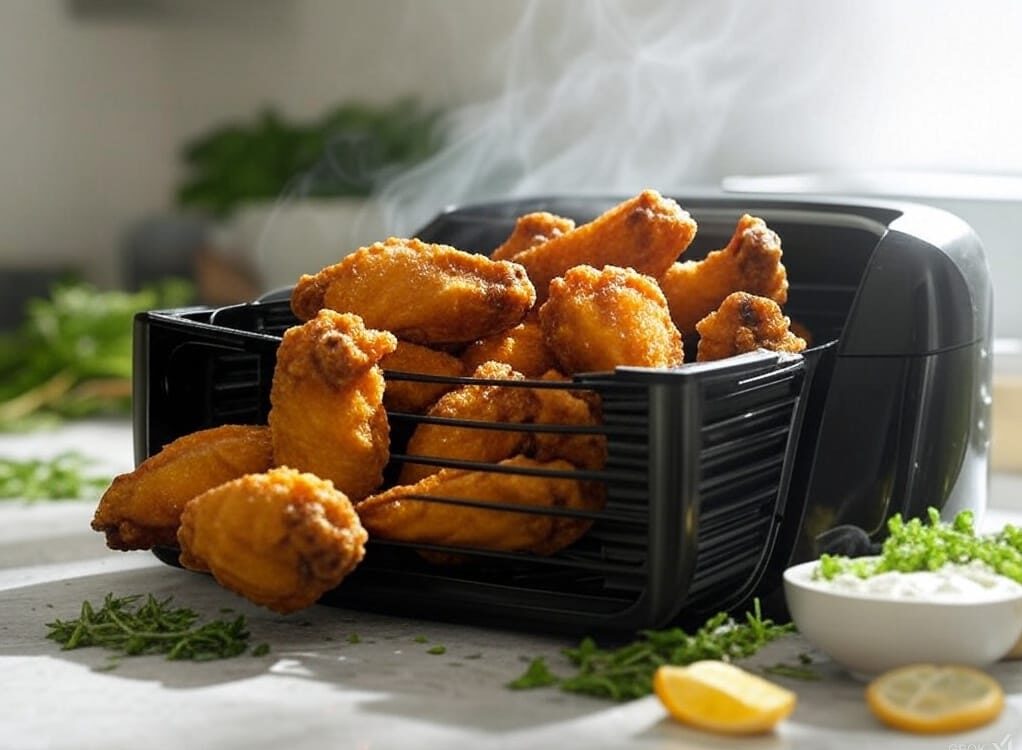
The Great Wing Debate: Comfort Food or Nutritional Powerhouse?
In 1964, the Anchor Bar in Buffalo, New York, faced a kitchen dilemma: an unexpected shipment of chicken wings. What emerged was a dish that would ignite America’s obsession—Buffalo wings, slathered in hot sauce and butter. Six decades later, this bar snack has evolved into a $1.3 billion annual industry, with wings gracing everything from Super Bowl spreads to Michelin-starred tasting menus. Yet as wellness culture booms, a question divides nutritionists and foodies alike: Can a food synonymous with indulgence ever be healthy?
The answer lies in nuance. Chicken wings, at their core, are a primal cut—lean muscle meat attached to bone, rich in collagen and protein. But their modern iterations—deep-fried, drenched in syrupy glaze, or smothered in blue cheese—have turned them into a battleground for the “health halo” effect. Dr. Priya Sharma, a culinary historian at NYU, notes: “Wings embody America’s love-hate relationship with food. They’re celebratory yet demonized, protein-packed yet calorie-dense. Their reputation hinges entirely on preparation.”
Consider this paradox:
- The Average American eats 90 pounds of chicken yearly, with wings accounting for 17% of sales at sports bars.
- Google Searches for “healthy chicken wings” surged 210% from 2020–2023, per Google Trends, as air fryers and keto diets reshaped home cooking.
“We’re seeing a cultural shift,” says Marcus Dupree, executive chef at Brooklyn’s The Wing Lab. “People want the crunch and camaraderie of wings without the guilt. That’s why we’ve added wood-fired, skinless wings with gochujang glaze to our menu—they outsell traditional Buffalo now.”
Chicken Wings 101: Anatomy, Nutrition, and Culinary Alchemy

A chicken wing comprises three parts: the drumette (meaty, bone-in), the flat (two-boned middle), and the tip (often discarded). Nutritionally, it’s a study in contrasts:
| Part | Calories (Baked, Skinless) | Protein | Fat | Key Nutrients |
|---|---|---|---|---|
| Drumette (1 oz) | 43 | 6.4g | 1.7g | Iron, B12, Zinc |
| Flat (1 oz) | 42 | 6.1g | 1.6g | Selenium, Phosphorus |
(Source: USDA FoodData Central)
The Skin Factor:
- With Skin: Adds 50–70 calories and 5g saturated fat per wing.
- Without Skin: Cuts fat by 55% but sacrifices collagen (linked to joint health).
Cooking Methods Matter:
- Baked: A 3.5-ounce skinless wing baked at 400°F retains 8.1g fat vs. 12.3g when fried.
- Air-Fried: Reduces fat absorption by 70% compared to deep-frying, per a 2022 Journal of Food Science study.
- Grilled: Infuses smoky flavor but risks charring—linked to carcinogens if overdone.
“Baking is the unsung hero,” says registered dietitian Clara Nguyen. “A six-piece serving of baked wings with lemon pepper seasoning delivers 36g protein—the same as a 5-ounce salmon fillet—for under 300 calories. Pair it with celery sticks, and you’ve got a balanced meal.”
The Sauce Paradox:
- Buffalo Sauce (1 tbsp): 25 calories, 0g fat (vinegar-based).
- Honey BBQ (1 tbsp): 45 calories, 11g sugar.
- Dry Rubs: Often sodium bombs—TGI Fridays’ Atomic seasoning packs 480mg per serving.
The Good, The Bad, and The Crispy: Breaking Down the Health Claims

Chicken wings sit at the intersection of indulgence and nutrition, sparking polarized debates among dietitians, chefs, and fitness enthusiasts. To separate fact from folklore, let’s dissect the science behind the hype.
The Good: Nutritional Benefits of Chicken Wings
- Protein Powerhouse:
A single baked, skinless wing delivers 6–9g of protein—a nutrient critical for muscle repair, immune function, and hormone production. For context, six wings (roughly 6 ounces) provide 36–54g protein, rivaling a grilled chicken breast.- Key Perk: The protein in wings is complete, containing all nine essential amino acids.
- Vitamin B12 Bonanza:
Chicken wings are rich in vitamin B12 (0.3mcg per wing), which supports nerve health and red blood cell formation. This is particularly vital for vegetarians or seniors at risk of deficiency. - Collagen Content:
The connective tissue in wings provides collagen, linked to improved skin elasticity and joint health. A 2019 Nutrients study found collagen peptides may reduce osteoarthritis pain by 40%. - Low-Carb Compatibility:
With 0g carbs per wing (skinless), they’re a staple for keto and diabetic diets. “Wings let patients enjoy comfort food without spiking blood sugar,” says Dr. Anita Rao, endocrinologist at Johns Hopkins.
The Bad: Hidden Pitfalls of Wing Culture
- Saturated Fat Overload:
While wings themselves aren’t inherently fatty, fried wings with skin pack up to 7g saturated fat each—nearly a third of the FDA’s daily limit. Regular consumption correlates with elevated LDL (“bad”) cholesterol, per the American Journal of Clinical Nutrition. - Sodium Sabotage:
Restaurant wings are often brined, sauced, or seasoned with salt-heavy rubs. A six-piece order at Buffalo Wild Wings contains 2,500mg sodium—more than the FDA’s daily recommendation (2,300mg). - The “Crispy” Conundrum:
Deep-frying wings at high heat generates acrylamide, a potential carcinogen, and advanced glycation end products (AGEs), which accelerate aging and inflammation. - Sauce Swaps:
While buffalo sauce is relatively benign (25 calories/tbsp), popular options like honey mustard (60 calories) or blue cheese dip (150 calories) can double a meal’s caloric load.
The Crispy: How Preparation Defines Health Outcomes
| Method | Calories per Wing | Total Fat | Key Risk/Benefit |
|---|---|---|---|
| Fried (with skin) | 100 | 7g | High in AGEs, acrylamide |
| Baked (skinless) | 43 | 1.7g | Retains protein, lowers fat |
| Air-Fried | 55 | 3.2g | 70% less oil; preserves crispiness |
| Grilled | 60 | 4g | Adds smoky flavor; moderate fat |
Source: USDA, Journal of Food Science (2022)
Pro Tip: Marinate wings in apple cider vinegar or lemon juice before baking—acids reduce AGE formation by 50%, per Food Chemistry.
The Diabetic Dilemma: Can You Eat Wings Without Guilt?

For the 38 million Americans with diabetes, wings pose a paradox: They’re low-carb but often prepared in ways that sabotage metabolic health. Here’s how to navigate the minefield:
The Risks
- Fried Skin: The crispy skin on wings is laden with saturated fat, which worsens insulin resistance. A 2021 Diabetes Care study found that diets high in saturated fat increased type 2 diabetes risk by 23%.
- Sweet Sauces: Teriyaki and honey BBQ sauces can contain 10–15g sugar per tablespoon, spiking blood glucose levels.
- Portion Distortion: Restaurants like Wingstop serve 10–20 wings per order—a recipe for overeating.
The Solutions
- Skinless and Saucy (Smartly):
- Remove the skin to slash saturated fat by 55%.
- Opt for vinegar-based hot sauces (0g sugar) or yogurt-based dips (Greek yogurt + dill = 30 calories/tbsp).
- Air Fryer Alchemy:
- Air-frying mimics the crunch of deep-frying without the oil. A 2023 Clinical Nutrition trial found that type 2 diabetics who air-fried meals lowered their HbA1c by 0.5% over six months.
- Pair Strategically:
- Balance wings with fiber-rich sides like roasted Brussels sprouts or a kale salad. Fiber slows glucose absorption, preventing spikes.
- Homemade Hacks:
- Try this diabetes-friendly rub: smoked paprika, garlic powder, cumin, and a dash of espresso (for depth).
Success Story:
James Carter, 58, a type 2 diabetic from Austin, swapped fried takeout wings for homemade air-fried versions. “My HbA1c dropped from 7.2% to 6.4% in four months,” he says. “I didn’t feel deprived—just smarter.”
The Verdict for Diabetics
Yes, wings can fit into a diabetic diet—if you:
- Bake or air-fry them skinless.
- Avoid sugary sauces (stick to herbs, citrus, or chili flakes).
- Limit portions to 4–6 wings per meal.
For a deeper dive into balancing diabetes and fried foods, see Can Diabetics Eat Fried Chicken Without the Skin?.
The Weight Loss Question: Friend or Foe?

Chicken wings, with their irresistible crunch and communal appeal, seem antithetical to weight loss goals. But like most foods, their role in a diet hinges on context: preparation, portion size, and pairing. Let’s unpack the science—and psychology—of wings in the weight loss equation.
Why Wings Can Work for Weight Loss
- Protein-Driven Satiety:
Protein is the most satiating macronutrient, and wings deliver it in spades. A 2023 Nutrition Reviews meta-analysis found that high-protein snacks reduce subsequent calorie intake by 12% compared to carb-heavy options. Six baked, skinless wings (36g protein) can stave off hunger for hours, making them a strategic choice for intermittent fasters or low-carb dieters. - The Air Fryer Advantage:
Air-frying slashes fat content without sacrificing texture. A study in Foods (2022) showed air-fried wings retain 89% of their crispiness while absorbing 70% less oil than deep-fried versions. For weight loss, this means a six-wing meal drops from ~600 calories (fried) to ~330 calories (air-fried). - Mindful Indulgence:
Deprivation often backfires. Allowing controlled portions of craveable foods like wings can improve diet adherence. “Including wings in a calorie deficit helps people stick to their plan long-term,” says Dr. Rachel Lee, behavioral nutritionist at UCLA.
Where Wings Derail Diets
- Portion Inflation:
Restaurants like Wingstop market “10 for $10” deals, normalizing oversized meals. Ten fried wings with ranch dip exceed 1,200 calories—nearly a full day’s intake for sedentary adults. - The Sauced-and-Fried Double Whammy:
Frying adds 55 calories per wing; drowning them in honey BBQ sauce tacks on another 150 calories. Combined, this turns a 300-calorie protein snack into a 900-calorie indulgence. - Alcohol Pairing Trap:
Wings and beer are a cultural staple, but alcohol lowers inhibitions and stimulates appetite. A Physiology & Behavior study found people consume 30% more calories when pairing savory snacks with alcohol.
The Weight Loss Verdict
- Yes, If:
- Prepared baked, grilled, or air-fried (skinless).
- Portioned to 4–6 wings per meal.
- Paired with veggie sticks and vinegar-based dips.
- No, If:
- Fried, sauced, and served in double-digit quantities.
- Eaten mindlessly during sports marathons (the average NFL viewer consumes 2,400 calories during a game, per Forbes).
Pro Tip: Use a “wing budget” strategy. Craving fried wings? Allocate 3 fried + 3 baked to halve calories while satisfying the crunch urge.
For a deeper dive into fried food’s role in weight management, see Is Fried Chicken Bad for Weight Loss?.
Chicken Wings vs. Chicken Feet: A Cholesterol Showdown

While wings dominate Western bar menus, chicken feet are a global delicacy—braised in Chinese dim sum, stewed in Jamaican soups, or grilled in South Africa. But how do these two offcuts compare nutritionally, particularly for cholesterol-conscious eaters?
The Nutritional Face-Off
| Nutrient (per 100g) | Chicken Wings (Skinless) | Chicken Feet |
|---|---|---|
| Calories | 203 | 215 |
| Protein | 30.5g | 19g |
| Total Fat | 8.1g | 15g |
| Saturated Fat | 2.3g | 4.2g |
| Cholesterol | 85mg | 135mg |
| Collagen | Moderate | Very High |
| Key Minerals | Iron, Zinc | Calcium, Phosphorus |
(Sources: USDA, Chinese Food Composition Tables)
The Case for Wings
- Lower Cholesterol: With 85mg per 100g vs. 135mg in feet, wings are safer for those monitoring LDL levels.
- Protein Density: 30.5g protein makes wings ideal for muscle building.
- Versatility: Easily adapted to low-fat preparations (baked, air-fried).
The Case for Feet
- Collagen Content: Feet are 70% collagen by dry weight, promoting joint health and skin elasticity. A 2021 Nutrients study found collagen supplementation reduced arthritis pain by 43%.
- Global Tradition: In Traditional Chinese Medicine, chicken feet are believed to boost qi (energy) and lactation.
The Cholesterol Myth?
While chicken feet have 59% more cholesterol than wings, recent research complicates the narrative:
- Dietary Cholesterol ≠ Blood Cholesterol: For 75% of people, saturated fat impacts blood cholesterol more than dietary cholesterol itself, per the Harvard School of Public Health.
- Context Matters: Jamaican chicken foot soup (with veggies) provides balanced nutrition, while fried feet with palm oil (common in West Africa) heighten heart risks.
Expert Take:
“Feet’s collagen benefits outweigh their cholesterol content for most,” says Dr. Mei Lin, a Taipei-based nutritionist. “But wings are the smarter choice for athletes or those prioritizing protein.”
For a full breakdown of cholesterol in poultry, explore Is Chicken Feet High in Cholesterol?.
Cultural Spotlight: Wings vs. Feet Across Cuisines
- USA: Wings = game-day indulgence (average consumption: 27 wings/person during Super Bowl).
- China: Feet = dim sum staple, prized for texture and “beauty benefits.”
- Jamaica: “Chicken foot soup” = postpartum recovery food, simmered with yams and callaloo.
- South Africa: “Walkie Talkies” (grilled feet and heads) = street food icon.
The Final Tally
- Choose Wings For: High protein, lower cholesterol, and weight loss-friendly prep.
- Choose Feet For: Collagen boost, cultural culinary exploration, and mineral diversity.
5 Surprising Facts About Chicken Wings
Chicken wings are more than just a game-day staple—they’re a cultural phenomenon with a rich history and unexpected quirks. Here are five lesser-known truths that redefine this beloved dish:
Buffalo Wings Were Born From Necessity

The iconic Buffalo wing wasn’t crafted by a gourmet chef but by a harried bar owner. In 1964, Teressa Bellissimo of Buffalo’s Anchor Bar received an accidental shipment of wings instead of necks for her spaghetti sauce. To avoid waste, she deep-fried them, tossed them in hot sauce, and served them with celery and blue cheese—a dish now celebrated every September 29 on National Chicken Wing Day.
Wings Fueled the NFL’s Rise

The NFL’s explosive growth in the 1980s paralleled the wings’ popularity. As Monday Night Football captivated audiences, bars began offering “all-you-can-eat wing nights” to draw crowds. By 1990, wing consumption had tripled, turning the NFL-Wing symbiosis into a $1.3 billion industry.
They’re a Global Canvas

While Americans favor Buffalo sauce, wings morph across borders:
- South Korea: Dakgangjeong (soy-glazed, fried wings dusted with sesame seeds).
- Nigeria: “Peppered wings” marinated in Scotch bonnet and ginger.
- Poland: Skrzydełka, smoked over applewood and served with horseradish cream.
The “Wing Flat” Is a Modern Obsession

Historically, wings were discarded or used for stock. The flat—now a fan favorite—gained prominence in the 1970s as bars realized its crispier skin-to-meat ratio. Today, 62% of U.S. wing lovers prefer flats, per a YouGov poll.
Air Fryers Revolutionized Home Wing Culture

Air fryer sales surged 300% during the pandemic, with wings driving demand. A 2023 Consumer Reports survey found 78% of air fryer owners use them primarily for wings, citing “guilt-free crunch” as the top reason.
For more quirky wing lore, explore 10 Fascinating Facts About Chicken Wings.
The Verdict: Are Wings Good for You?
The answer isn’t a simple yes or no—it’s a spectrum shaped by preparation, portion, and perspective. Let’s synthesize the evidence:
The Case For
- Protein-Packed and Nutrient-Dense:
Skinless, baked wings offer 6.4g protein and essential nutrients (iron, B12, zinc) per ounce—comparable to lean turkey. - Low-Carb Flexibility:
With zero carbs, they’re keto- and diabetic-friendly when sauced wisely (e.g., vinegar-based hot sauce). - Collagen Benefits:
The connective tissue provides collagen, which a 2022 Journal of Cosmetic Dermatology study linked to reduced wrinkles and joint pain.
The Case Against
- Calorie Creep:
Fried wings with ranch dip can clock 1,000+ calories for six—equivalent to two Big Macs. - Sodium Overload:
Restaurant wings often exceed 2,000mg sodium per serving, risking hypertension. - The “Healthy Halo” Trap:
Labels like “gluten-free” or “organic” don’t negate frying’s health risks.
The Balanced Approach
To enjoy wings without compromise:
- Prep Smart: Air-fry or bake skinless wings at 400°F for 40 minutes (crispiness without oil).
- Sauce Strategically: Opt for:
- Buffalo: 25 calories/tbsp (vinegar, cayenne, garlic).
- Yogurt-Dill: 30 calories/tbsp (Greek yogurt, lemon, fresh herbs).
- Pair Wisely: Serve with:
- Roasted Veggies: Brussels sprouts or broccoli (fiber counterbalances fat).
- Quinoa Salad: Adds plant-based protein and complex carbs.
Pro Tip: Use a meat thermometer—wings are safe at 165°F internally but dry out past 185°F.
What Experts Say
- Dr. Sarah Mitchell, Nutritionist: “Wings can absolutely fit into a healthy diet—if they’re the side dish, not the main event.”
- Chef Kwame Onwuachi: “Respect the wing. Its flavor doesn’t need to be buried in sauce; let the quality of the bird shine.”
The Final Word
Chicken wings aren’t inherently “good” or “bad”—they’re a blank slate. Their health impact hinges on:
- Preparation: Baked > Fried.
- Portion: 4–6 wings, not 20.
- Context: A balanced plate with veggies, not a solo binge.
As the Journal of Culinary Science notes: “No food is a villain. Wings, in moderation, are a celebration of flavor and community—not a dietary felony.”
FAQ
Are wings good for muscle building?
Yes! Their high protein content supports muscle repair and growth.
Is fried chicken bad for weight loss?
Frequent fried wing consumption can hinder weight loss due to excess calories and unhealthy fats. Opt for baked versions.

